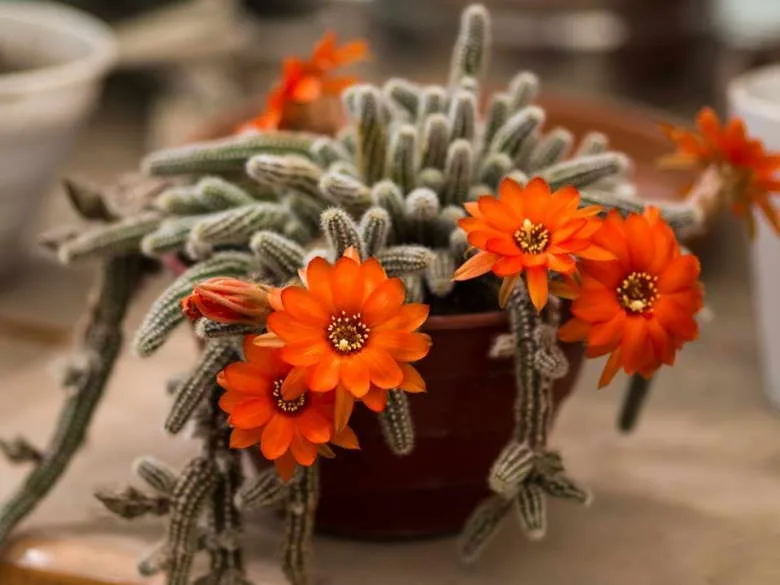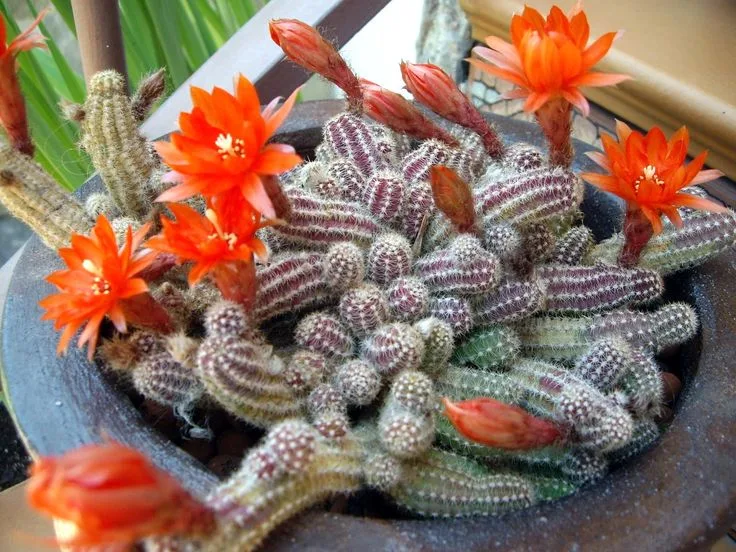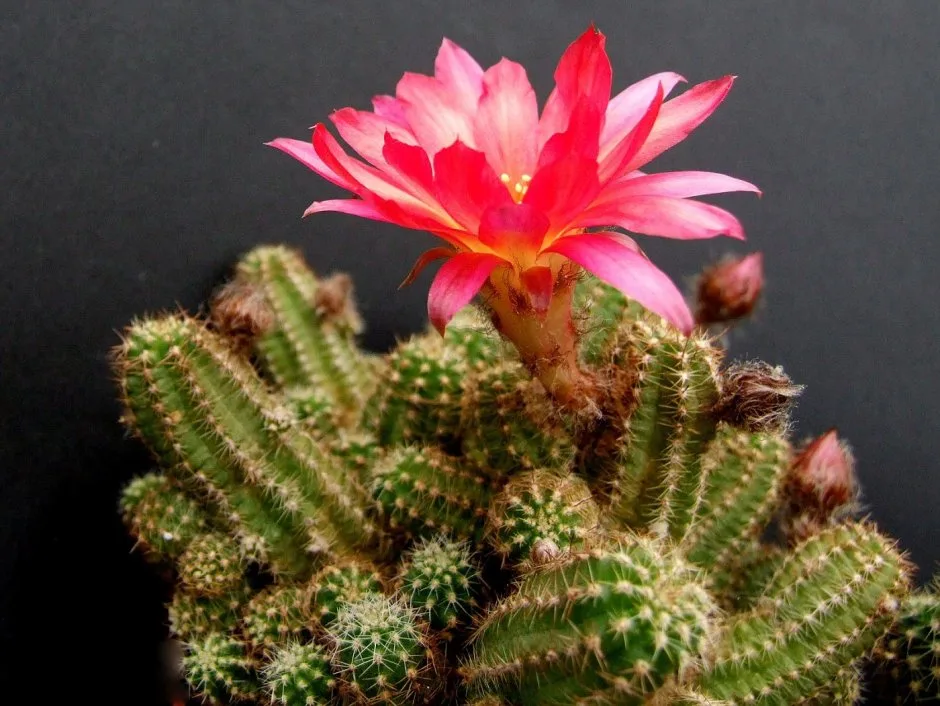Index
Introduction
Echinopsis chamaecereus, also known as the snowball cactus, is a species of cactus native to the South American region. This cactus is recognizable by its globular shape and the beautiful clusters of flowers it produces during spring and summer. Its flowers, which can be white, pink or yellow, add a splash of color to the environment, making it a charming addition to succulent and cactus gardens, as well as indoor plant collections.
Meaning of Echinopsis chamaecereus
Echinopsis chamaecereus is an easy plant to grow, making it ideal for beginners in cactus and succulent gardening. It requires little care and can thrive in a variety of conditions, as long as it receives plenty of direct sunlight and is planted in well-drained soil. In addition to its ornamental beauty, this cactus carries with it a symbolic meaning of endurance and perseverance, representing the ability to thrive even in adverse conditions. Its presence in an environment can inspire resilience and determination in the face of life’s challenges.
| Item | Information about Echinopsis chamaecereus |
|---|---|
| Common Name | Snowball cactus |
| Botanical Name | Echinopsis chamaecereus |
| Family | Cactaceae |
| Plant Type | Succulent, Cactus |
| Adult size | Up to 15 cm tall |
| Sun exposure | Full sun |
| Soil type | Well-drained soil |
| soil pH | Neutral to slightly acidic (pH 6.0-7.0) |
| Flowering Season | Spring and summer |
| Flower color | White, pink, yellow |
| Native Area | South America |
| Toxicity | Non-toxic |

How to care for Echinopsis chamaecereus
When it comes to caring for Echinopsis chamaecereus, some aspects must be considered to ensure its good development and health. Here are some tips on how to care for this beautiful succulent:
Light
Echinopsis chamaecereus prefers direct, intense sunlight. So make sure you place it in a spot where it receives at least 6 hours of direct sunlight a day. This will help the plant grow healthily and produce vibrant flowers.
Soil
Use well-drained, sandy soil. The ideal soil for Echinopsis chamaecereus is one that allows good drainage, preventing water from accumulating around the roots. A mixture of cacti and succulents is an excellent choice to ensure the right soil.
Watering
Water moderately, allowing the soil to dry out between waterings. Echinopsis chamaecereus is a succulent plant and can store water in its leaves and stems. Therefore, water only when the soil is completely dry to avoid root rot.
Temperature and humidity
Keep the plant in warm, moderate temperatures. This succulent prefers temperatures between 21°C and 27°C during the day and does not tolerate frost. In addition, it is not necessary to provide additional humidity, as it is drought tolerant.
Fertilizing
Fertilize during spring and summer with a balanced fertilizer for cacti and succulents. Follow the manufacturer’s instructions for the correct application of the fertilizer. Avoid fertilizing during the winter, when the plant is resting.
By following these care guidelines, you can enjoy the beauty and vigor of Echinopsis chamaecereus in your home or garden.

How to make Echinopsis chamaecereus cuttings
If you want to propagate your Echinopsis chamaecereus and expand your succulent collection, making cuttings is a great option. Here are some instructions on how to make cuttings of this lovely plant:
Propagation by Cuttings
1.Choice of Material: Select a healthy, mature stem from your Echinopsis chamaecereus to make the cutting. Make sure the stem is at least 10 cm long and free from damage or disease.
2. Drying the cutting: Leave the cut cutting in a dry, shaded place for a few days to allow the cut wound to heal and dry out. This will help prevent the cutting from rotting when it is planted.
3. Planting the cutting: After drying, plant the cutting in a light, well-drained substrate, such as a mixture of cacti and succulents. Bury about half of the cutting in the soil and water lightly to aid rooting.
How to plant Echinopsis chamaecereus
Now that you have cuttings ready or have acquired rooted plants, it’s time to plant them so that they can grow and thrive. Here are some tips on how to plant Echinopsis chamaecereus:
Choosing a pot: Select a suitably sized pot with drainage holes in the bottom to ensure good drainage. Make sure the pot is slightly larger than the plant’s root system.
Preparing thesoil: Fill the pot with a soil mixture for cacti and succulents, or prepare your own substrate using sand, perlite and peat in equal parts. Make sure the soil is well-drained and aerated.
Planting the seedling: Make a small hole in the potting soil and carefully place the seedling in the center. Press the soil around the base of the seedling to secure it in place and water lightly to settle the soil.
Initial care: After planting, place the pot in a sunny spot and water the seedling sparingly, allowing the soil to dry out between waterings. Avoid overwatering to prevent the roots from rotting. Over time, your Echinopsis chamaecereus will grow and develop, giving you many years of succulent beauty.

Most common pests and diseases
When growing Echinopsis chamaecereus, it’s important to be aware of the pests and diseases that can affect this succulent. Here is a list of the most common ones:
- Mealybugs: Insects that feed on the plant’s sap, leaving sticky spots on the leaves and causing the plant to weaken.
- Mites: Small arachnids that feed on the leaves, causing yellowing and deformation.
- Root rot: Caused by excess moisture in the soil, resulting in waterlogged and rotten roots.
- Powdery mildew: A fungus that manifests itself as a powdery white coating on the leaves, causing the plant to weaken.
- Mildew: Another fungus that causes yellow spots on the leaves and can lead to premature leaf fall.
Common Problems and Their Solutions
Pest Control
1. Treatment with insecticides: Apply an insecticide suitable for controlling mealybugs and mites, following the manufacturer’s instructions. Repeat the treatment as necessary to completely eliminate the pests.
Fungal Disease Treatment
1. Removalof Affected Leaves: Remove leaves affected by powdery mildew and downy mildew to prevent the spread of the disease. Dispose of the removed leaves in a place away from the garden.
2. Fungicide application: Apply specific fungicides to treat powdery mildew and downy mildew, following label instructions for an effective application.
Preventing Soil Problems
1.Improve drainage: Make sure the soil has good drainage to prevent root rot. Avoid overwatering and grow Echinopsis chamaecereus in a pot with adequate drainage holes.
Proper maintenance
1.Regular monitoring: Inspect the plant regularly for signs of pest or disease infestation. The sooner you identify the problem, the easier it will be to control.
2. Tool Hygiene: Keep gardening tools clean and sterilized to prevent the spread of pests and diseases from one plant to another.

Curiosities and myths
In addition to its beauty and resistance, Echinopsis chamaecereus carries with it a number of interesting curiosities and myths. Let’s explore some of them:
Origins and characteristics
1. Origin in South America: Echinopsis chamaecereus is native to arid and semi-arid regions of South America, where it grows in rocky, dry soils. Its ability to store water in its succulent structures makes it well adapted to these environments.
2. Name “Snowball Cactus”: The nickname “snowball cactus” derives from the white flowers that cover the plant during flowering, creating the illusion of a snowball on top of the cactus.
Myths and symbolism
1. Protection from Evil: In some cultures, it is believed that growing Echinopsis chamaecereus around the house can protect against evil and ward off negative energies. Its spines are said to ward off evil spirits and negative vibrations.
2. Luck and Prosperity: Another popular myth associated with Echinopsis chamaecereus is that having a specimen of this plant in the house can attract luck and prosperity to the residents, especially if it is gifted by a loved one.
Although many of these myths may just be legends, they add a layer of fascination to the already impressive Echinopsis chamaecereus, making it a truly captivating plant.
Conclusion
In summary, Echinopsis chamaecereus is a fascinating succulent, known for its exotic beauty, endurance and the myths that surround it. Originally from South America, this plant has spectacular flowering, reminiscent of a snowball, and is able to thrive in arid and dry environments.
In addition to its aesthetic appeal, Echinopsis chamaecereus is shrouded in symbolism and cultural stories, such as the belief in its ability to ward off evil and attract luck. Whether for its ornamental appearance or the legends that accompany it, growing this succulent is a rewarding experience that connects us to nature and the rich tradition of plants in human culture.
Frequently asked questions
What is peanut cactus?
The peanut cactus, also known by its scientific name Senecio articulatus, is a succulent plant belonging to the Asteraceae family. Its common name derives from the resemblance of its articulated stems to peanuts.
How long does it take for the peanut cactus to flower?
The time it takes for the peanut cactus to flower can vary depending on the growing conditions and the stage of development of the plant. Generally, flowering occurs during spring or summer and can last a few weeks.
How to care for Chamaecereus echinopsis?
To care for Echinopsis chamaecereus, it is important to provide it with direct sunlight and moderate watering, allowing the soil to dry out between breaks. In addition, it is essential to use well-drained soil and provide light fertilization during the period of active growth.







